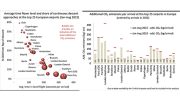Europe’s airspace users expected to cover up to €5.4bn in lost ANSP revenues through higher ATC charges beginning in 2023
12 May 2021
- Revised regulation will see airspace users pay higher air traffic control (ATC) charges as a result of weaker performance targets approved by member states for air navigation services.
- Airspace users repeatedly urged states to use COVID-19 EU Recovery Funds to close revenue gaps – not make airspace users and their passengers foot the bill.
- Updated regulation will siphon money away from airspace users’ planned decarbonisation ambitions.
Member states yesterday approved a revised regulation updating the EU-wide performance targets for air navigation service providers (ANSPs). Previous targets set were based off of 2019 traffic levels, which have subsequently plunged by more than 60 per cent last year1 due to the COVID-19 crisis, government-imposed travel restrictions and the closure of EU borders. This has resulted in a €5.4bn revenue shortfall for Europe’s ANSPs, who failed to react to the drop in traffic by reducing their expenditures accordingly. Across the wider aviation supply chain – and even beyond, the decision taken by member states is unique. No other regulation, airport charges scheme or normal business contracting mechanism foresees airspace users shouldering previous losses from their suppliers, especially not in extraordinary times like the COVID-19 crisis, which is clearly a force majeure event.
During tense negotiations over the last six months, member states have shown a complete unwillingness to follow the European Commission’s recommendations to take the long-term impact of the COVID-19 crisis on airspace users into account when setting updated performance targets for ATM services. Current forecasts indicate a recovery for EU airlines is not likely until 2024 at the earliest.
“Like airlines and other aviation stakeholders, air navigation service providers were expected to reduce their costs dramatically over the last year, reflecting the decline in traffic – and not simply continue with business as usual. While ANSP service requirements fell by 60 per cent, they opted to reduce their costs by just one per cent”,2 said Thomas Reynaert, Managing Director, Airlines for Europe (A4E).
“The targets approved by states are by no means ambitious and will consequently impede the much-needed recovery of our sector, including airlines’ investment capacity to support digitalisation and decarbonisation solutions through our Destination 2050 initiative. States have rather chosen to protect their monopoly ANSPs and themselves from paying for revenue gaps from a crisis which has resulted in €22bn3 in losses for European carriers”, Reynaert added.
Alternatively, member states could have made use of COVID-19 EU Recovery Funds, other national funding possibilities or existing regulatory mechanisms to close their ANSP revenue shortfalls, instead.
The updated targets clearly show the conflict of interest in the target setting process. Member states – as owners of the large majority of ANSPs – set the targets and can define how much profit they will make, whilst airspace users and their passengers remain at their mercy. The targets also reveal a lack of understanding by states about the long-term recovery needs of airspace users, including ambitious commitments to ‘build back better’ from the crisis.
“At a time when airlines have already been financially crippled through no fault of their own, we are bitterly disappointed that states continue to throttle the economic and sustainable recovery of the aviation sector, essentially putting regional connectivity now even further at risk”, said Montserrat Barriga, Director General, European Regions Airline Association (ERA).
Airspace users urge ANSPs and member states to support the industry’s recovery by reducing their costs and setting more challenging national performance targets, which would also benefit the environment by facilitating operational efficiencies. At the same time, member states and the European Parliament must ensure that the ongoing revision of the Single European Sky framework (SES 2+) provides a meaningful and effective performance regulation for air navigation service providers that addresses the current imbalance and conflict of interests.
Airlines for Europe (A4E) is Europe’s largest airline association, based in Brussels. The organisation advocates on behalf of its 16 airline group members to help shape EU aviation policy to the benefit of consumers, ensuring a continued safe and competitive air transport market. Follow us on Twitter @A4Europe.
The European Business Aviation Association (EBAA) is the leading organisation for operators of business aircraft in Europe. Our mission is to enable responsible, sustainable growth for Business aviation, enhance connectivity and create opportunities. EBAA works to improve safety standards and share knowledge, to further positive regulation and to ease all aspects of closely tailored, flexible, point to point air transportation for individuals, governments, businesses and local communities in the most time-efficient way possible. Founded in 1977 and based in Brussels, EBAA represents +700 members companies, corporate operators, commercial operators, manufacturers, airports, fixed-based operators, and more, with a total fleet of +1,000 aircraft. Follow us on Twitter, LinkedIn, Instagram and Facebook, or visit our website on www.ebaa.org.
The European Helicopter Association (EHA) is a non-profit Association representing the interests of the rotorcraft operators at European and international Institutions. EHA has been influencing safety standards and growth of the European rotorcraft industry, creating new opportunities for its members since its foundation in 1980. EHA represents more than 500 Members in 12 European countries.
European Regions Airline Association (ERA) – Founded in 1980, European Regions Airline Association (ERA) is a non-profit trade association representing over 60 airlines and around 150 companies involved in European air transport and is the only association representing the entire spectrum of companies involved in European aviation. The association promotes the interests of European airlines by lobbying European regulatory bodies on policy matters, promoting the social and economic importance of air transport and its environmental commitments.
The International Council of Aircraft Owner and Pilot Associations (IAOPA) is a nonprofit federation of 82 autonomous, nongovernmental, national general aviation organizations. IAOPA Europe has affiliates in 32 European states. The combined total of individuals represented by these constituent member groups of IAOPA is nearly 400,000 pilots, who fly general aviation aircraft for business, fun, and personal transportation.
Source : ERAA














Be the first to comment on "Europe’s airspace users expected to cover up to €5.4bn in lost revenues"